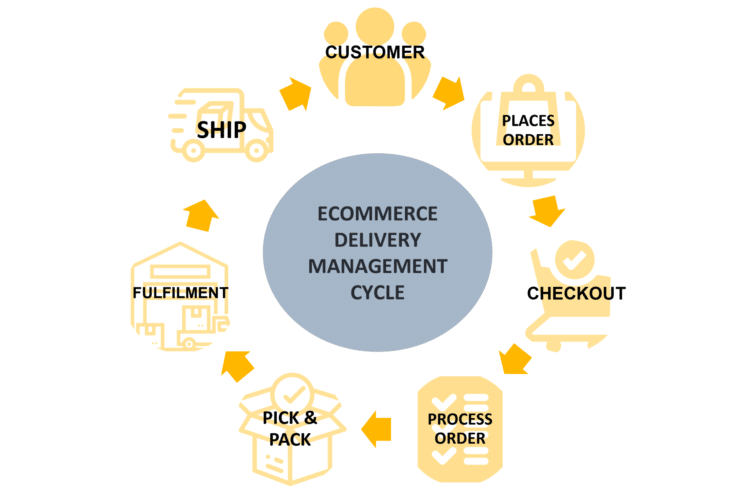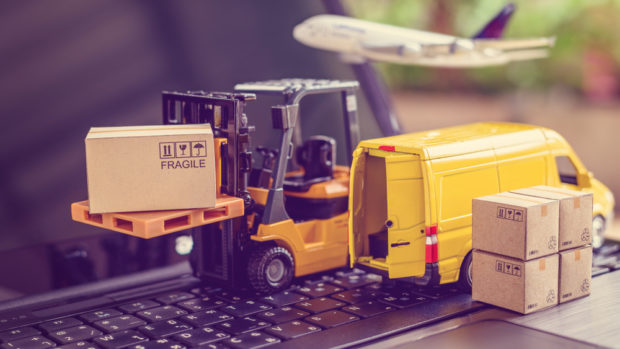
Online purchasing and delivery management is constantly evolving. Retailers are struggling to keep up with the changing needs of border and carrier regulations. And customers are demanding faster and more personalised deliveries.
Streamline your shipping operation
Fortunately, help is available. By using a multi carrier delivery management system such as Intersoft’s Intelligent Shipper, you can streamline your entire delivery process using one simple integrated API.
In this article, we look at what delivery management software is, how it works and what an eCommerce shipping system can do to help you improve your fulfilment operation, save time and money, and boost business growth.
What is a delivery management system?
Put simply, a delivery management system is a cloud-based software that streamlines and automates your entire shipping process – from the consumer selecting their preferred delivery method at the initial order to receiving their goods at the final doorstep delivery.
Delivery management software enables eCommerce retailers to effectively manage multiple carriers domestically and internationally from a single fully integrated platform.
The ability to use multiple carriers allows businesses to switch between the services that offer their customers greater delivery choice, reduce costs and improve their processes – without the headache of integrating with each carrier individually.
Who does delivery management software benefit?
Any retailers or fulfilment operation shipping parcels to their customers either in the UK or around the globe, to and from multiple locations, will benefit from an integrated shipping platform for eCommerce.
From an eCommerce start up to a multinational brand, everyone can improve in this space.
The software is particularly suitable for retailers who don’t have the time and resources to continually manage multiple carrier integrations themselves.
Benefits of multi carrier software
Carriers are continually updating label shipping requirements and retailers need to stay on top of these developments, which is time-consuming and costly.
Having a reliable delivery management software provider to do this for them, allows retailers to focus on their core business. For example, a retailer such as ASOS would be able to continue selling and promoting clothing while their multi carrier software specialist takes care of the shipping.
Intersoft’s delivery management software benefits everyone, including the following markets:
- Fashion
- Homeware
- Sports goods
- Computer hardware and software
- Marketing, advertising and media
- Health products and pharmacies
- Arts and crafts
Delivery management systems also provide a much-needed solution for Third Party Logistics companies (3PLs) and Third Party Integrators (3PIs) who use the system to bridge the gap between customer and carriers. This ensures integrations are up to date, robust and secure.
What are the main benefits of a delivery management system?
- Delivery management software makes it faster, easier and cheaper for retailers to deliver multiple orders in multiple locations, both domestically and internationally.
- Being totally flexible and totally integrated, retailers don’t need to keep updating their shipping systems in response to changing carrier requirements, such as new services, label changes, data requirements and ever changing customs regulations.
- Retailers can easily integrate their preferred carriers to enable consumers with a host of convenient delivery options at checkout, from standard, next day or express delivery to flexible pick up and drop off locations and even green delivery.
- A last mile delivery management system integrates with order management and warehouse management systems, enabling retailers to fulfil orders seamlessly.
- The fully integrated platform monitors carriers at parcel level to give retailers a complete view of the delivery performance, ensuring costs can be managed and controlled.
- Delivery management solutions not only take care of fulfilling orders, they also enable integration of returns.

How do delivery management systems work?
Delivery management software has various touchpoints throughout the buying and fulfilment process, but in short carrier management software works in the planning of what carriers to deliver a customers order, managing of the various carriers depending on the weight or value of the items and finally in the optimising and execution of the item both during delivery (notifications and tracking) as well as how the item will be delivered (next day, lockers or deliver to store). We’ve summarised it in 5 steps below.
- A customer places an order on a retailer’s website or marketplace, such as eBay or Amazon.
- Before the customer confirms the order on the checkout screen, the retailer would offer a choice of delivery options. This is one of the touchpoints where delivery management software can be used as it integrates through an API into the retailer eCommerce online store and provides the choice of delivery options at checkout (such as next day, 3-4 days and deliver to home, locker or store) as set up by the retailer.
- Once an order is confirmed and paid for, it lands in the retailer’s order management system.
- The order is then picked and packed (usually from a picking list) and a delivery label printed which has been pulled from a carrier management system through an API (another touchpoint), where retailers can then choose how the system prints labels. They can be printed manually by scanning a barcode on the order paperwork or printed automatically from the order being generated, these options are available during the setup of the delivery management software.
- The parcel is then collected by the carrier and delivered to the customer.
How is label printing integrated into retailers’ systems?
There are three ways in which a retailer can integrate into delivery management software – API, Flat file or Manual.
API
Integrating via an API is the most effective way as it allows retailers and partners to manage orders and print labels automatically. It’s also more flexible in how they want to use the API in their processes. For example, they might want to print all the labels at once when all the day’s orders are ready to be packed.
Flat file
This hybrid method provides some of the automatic printing offered from the API system with the control of importing orders from a CSV file or similar. Retailers can simply click a button to generate all the labels in one go.
Manual
As the name suggests, retailers or partners can manually input individual orders into the delivery management system and print labels in batches or one at a time. This method is suitable for new retailers who want to branch out.
What are the features and benefits of the Intersoft Intelligent Shipper delivery management system?
Fully integrated API
Intelligent Shipper offers a fully integrated solution through a single API. This means retailers only need to use one API specification across all their carrier integrations. This is especially beneficial for retailers who have multiple carrier integrations as it saves time and money when carriers update any label or shipment requirements as Intersoft would simply deploy the updates across one API.
New carriers and services can also be added or removed easily, with no impact on warehouse operations or any need for hardware or software changes.
Real-time tracking
Intelligent Shipper offers tracking as standard, enabling you to track a parcel, keep informed on every step of a shipment’s journey, manage anticipated delays and re-assign deliveries if necessary. You can even go one step further with fully branded customised tracking and personalise emails and message notifications across all your deliveries.
Convenient delivery options
Intersoft’s delivery management software automatically picks the most efficient routes and options for ultimate flexibility. You can choose where items are picked up from (for example, warehouse, depot or store) and where they’re shipped to (for example, home, shop, office or locker).
Dashboard reporting
Intelligent Shipper provides intelligent business analytics to help you form insights and make informed decisions. You can easily see historical and real-time data on the number and location of shipments by the hour, day, week, month or year.
Returns process
Being able to offer your customers easy free returns has become vitally important for sales growth. With Intelligent Shipper you can brand customer communications, so they appear to come directly from you.
Your customers can even be directed to a branded landing page where they can complete details on why an item is being returned and produce a ‘free returns’ shipping label. Or you can go a step further and offer a paperless return option. This allows customers to use a QR code and have the label printed at the post office or local shop. This is useful for consumers who don’t have a printer at home.
Label manifesting and printing
Printing the correct label with all the necessary information for the carrier, quickly and easily, is one of the most important features of a delivery management system.
Intelligent Shipper offers several print features, including ‘Print Harvester’, which allows you to connect shipment orders or data files from a computer or network automatically.
‘Scan to Print’ triggers automatic label production to a chosen printer as you need it by scanning a barcode. And ‘Silent Printing’ is the smart solution that facilitates the automation and the production of shipping labels and associated documents by printing to your chosen printers automatically as soon as shipments are created. You can also use the label image provided by the API and print the label yourself.
If you’d like to find out how delivery management software can benefit your business – whether you’re a retailer, carrier, or fulfilment house contact Intersoft








Share